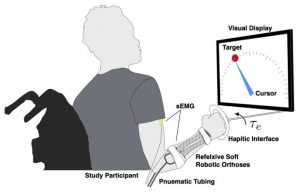1. One thing that helps
Engineers from the University of California are developing robotic clothing to help children with cerebral palsy. Current methods use robotic exoskeletons to assist in muscle performance, but these tend to be rigid and uncomfortable. These new robotic sleeves are made out of common textiles and are low-cost so everyone can afford them.
The sleeves have regions that inflate to provide movement to the limb.

“Let’s say you want to flex the elbow for a bicep curl. We can inject air into specially designed bladders embedded in the fabric that would propel the arm forward,” Jonathan Realmuto, project lead, said.
In addition to working on the mechanical aspect of the robotic sleeve, the engineers are also developing an algorithm that uses sensors to be more responsive. Changes in the voltages generated by the muscles can help the sleeve predict the wearer’s intention and adapt accordingly. While the tech is focused on helping children, the technique may also be used to help adults afflicted with motor diseases.
“If we can help kids brush their teeth, pour water or open doors, actions that others take for granted, it’s a huge win for them,” Realmuto said. “But it’s also a win for their families and caretakers.”
What I love about doing this newsletter is that it is always so easy to find topics for the “help” category. Technology is providing so many benefits in health, for all sorts of different people, and this is yet another example.
2. One to be wary of
The recent Optus hack that exposed about 40% of the Australian population’s data is possibly our biggest cyberattack to date. Names, birth dates, phone and driving license numbers were among the data the hackers obtained. This should raise alarm bells for us all. We need to be aware of what types of data is out there and how is it being used. I am particularly concerned about how our facial recognition data is captured, used and stored.
While facial recognition data is helpful to authorities, cameras being deployed from stores to schools capture a scary amount of data that puts people’s privacy at risk due to a lack of legislation.
“As we see facial recognition being used more and more, we need to crack down on the unnecessary collection of that information, then storage, then use and misuse,” former human rights commissioner Professor Edward Santow said. The professor and his UTS team have designed a model law that proposes the following:
- Facial recognition data being captured must be categorised into risk levels. Low-risk, such as those we use for unlocking phones. Medium-risk, like face scanners in establishments, and high-risk, scanners that not only capture the face but also infer more data such as sexuality or mood.
- High-risk collection would be banned entirely. This would make the hacking of facial recognition data less attractive to criminals.
- Risk ratings would be public and able to be challenged.
- Informed consent must be obtained from people having their faces scanned.
- Companies would be prohibited from using standard non-negotiable terms unless there was no other way for them to reasonably deliver the service.
With more scanners poised to be deployed throughout the world, the need for legislation has become urgent. It’s not just about protecting privacy. Data misuse and abuse have led to wrongful arrests that destroyed people’s lives. It’s time for legislation to catch up with technology.
3. One to amaze
All The Music Has Already Been Created
An AI has created every melody that it is possible to create. That is 68 billion melodies using 12 notes.
The idea is to help songwriters who are working within an industry increasingly likely to sue them for “copying” a melody. With every song that is written, the chances of creating something genuinely unique decreases. One of the issues is that if your melody sounds remotely similar to another song, that song’s owner can sue you for subconscious infringement – even if you claim you have never heard it. Just ask George Harrison and Radiohead.
Damien Riehl and Noah Rubin came up with Just Make Music. Using brute force – the same method used to crack passwords – they created an algorithm to come up with all mathematically possible melodies. They then uploaded these melodies as MIDI files and dedicated it to Creative Commons Zero (CC0) so musicians can keep creating without fear of lawsuits. Their argument is that melodies are just numbers arranged in a particular order – and you can’t copyright numbers!
I don’t think anyone is suggesting that the likes of Vanilla Ice stealing a Queen song, or Ghostbusters ripping off Huey Lewis shouldn’t be challenged but the prevalence of lawsuits for something sounding vaguely similar is crushing creativity. Hopefully this innovation unleashes artists to create some astounding new tunes that will make us stop, collaborate and listen 🙂